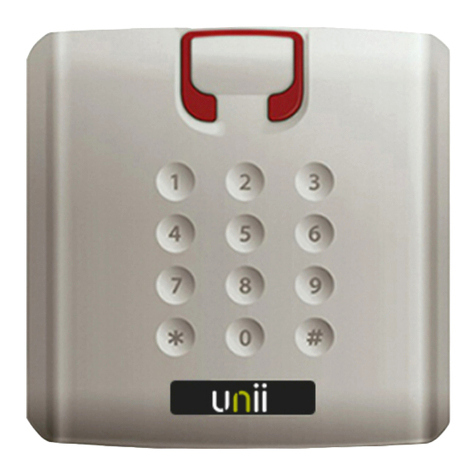
7
Outputs
-Speaker (LS) output 8-ohm 15W. The LS output has a polyfuse of 750 mA. In the programming (LS
monitoring) of the control panel it can be set that the LS output is monitored against tampering. If this
function is switched on, the loudspeaker itself functions as an End-Of-Line (EOL) resistor, no additional
resistor is required.
-Siren output 7W. The siren output has a polyfuse of 500 mA. In the programming (siren monitoring) of the
control panel it can be set that the siren output is monitored against tampering. If this function is switched
on, a 1k8 Ohm End-Of-Line (EOL) resistor must be placed in parallel over the siren terminals.
-2 potential-free relay contacts (maximum current through the contact is 750mA max. @ 30VDC)
-2 Open Collector (O.C.) outputs, maximum load per output is 200 mA. A cable of no more than 30 m may
be connected to these outputs. The OC outputs are provided with a polyfuse of 200 mA.
-3 connections for (outgoing) + 12V supply voltage, together with one polyfuse of 750 mA.
-1 connection for (outgoing) + 12V power supply via the RS-485 bus, equipped with a polyfused of 750 mA.
RS-485 bus
The UNii uses an RS-485 data bus to connect different bus components. The maximum cable length of an RS-
485 bus is 1,200 m. This distance can only be achieved when using the prescribed FTP cable (FTP = foiled twisted
pair, “shielded with twisted pairs”, data cable at least 2x2x0.5mm + shielding). Always ensure that the shielding of
the RS-485 cable is unilaterally connected to ground, for example in the control panel. Ground screws are
provided for this at the recess in the rear of the metal housing. A 4-core FTP cable is always made up of 2 pairs of
wires (for example red + blue twisted together and green + yellow twisted together), make sure that 1 wire pair (for
example red and blue) is used for the power supply (+ 12V and 0V) and the other conductor pair (for example,
yellow and green) for data communication (A and B). If the prescribed cable is not used, interference may occur
on the RS-485 data bus that negatively affects the system. With a long RS-485 bus (longer than approx. 500 m) it
is not allowed to make star connections between the UNii control panel and the other components. Ensure that all
components are connected in one line. The bus may never be longer than 1200 m.
All bus components must be addressed. This can be done in two ways, manually or automatically. Manually by
setting the address of each bus component itself (unique address on rotary switch or dip switches) or
automatically whereby the addresses are determined by the UNii itself. To do this, set all bus components to
address 0. Optionally, the assigned addresses can be adjusted afterwards with the help of UNii manager.
Cable length RS-485 bus
The maximum distance between a powered and not powered bus component depends on the resistance of the
cable and the power consumption of the relevant component. Consult the installation manual of the connected
components to find out the power consumption and minimum supply voltage. Example calculation: UNii keypad
with reader (art. code 004624/26):
Alphatronics RS-485 bus cable (art. code. 008653) has a resistance of 10Ω per 100m.
Minimum voltage for the keypad is 7.5 V and the power consumption when the keypad is active is 135 mA.




























